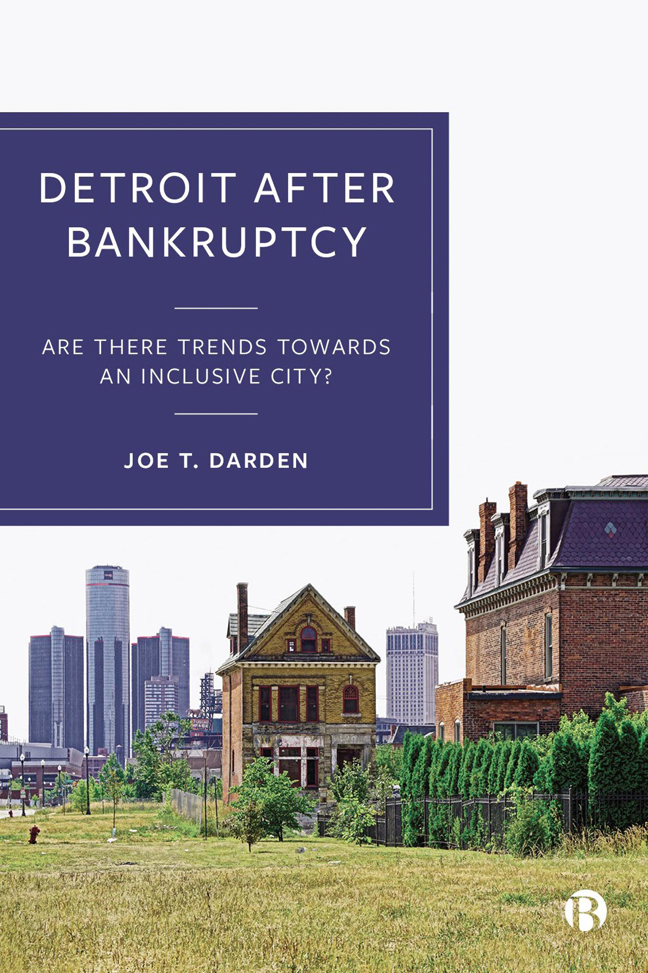Book contents
- Frontmatter
- Dedication
- Contents
- List of Figures and Tables
- Acknowledgments
- Preface
- 1 Antecedents to Bankruptcy
- 2 Detroit Bankruptcy: The Characteristics of the Decision Makers and the Differential Benefits Afterwards
- 3 The Postbankruptcy Social and Spatial Structure of Metropolitan Detroit: Anatomy of Class and Racial Residential Segregation
- 4 Gentrification: A New Method to Measure Where the Process Is Occurring by Neighborhood
- 5 The Uneven Distribution of Economic Redevelopment: Which Neighborhoods Are Excluded?
- 6 Black and Hispanic Underrepresentation in Business Ownership in a Majority-Black City
- 7 Racial Inequality in Student Academic Achievement Levels: A Neighborhood Solution to the Problem
- 8 Unequal Exposure to Crime in the City of Detroit: A New Method to Measure Exposure by the Characteristics of Neighborhoods
- 9 Solving the Problem of Extreme Race and Class Inequality: Implementing the Spatial Mobility Alternative
- 10 Conclusions: The Status of the Residents of Detroit after Bankruptcy
- References
- Index
8 - Unequal Exposure to Crime in the City of Detroit: A New Method to Measure Exposure by the Characteristics of Neighborhoods
Published online by Cambridge University Press: 25 January 2024
- Frontmatter
- Dedication
- Contents
- List of Figures and Tables
- Acknowledgments
- Preface
- 1 Antecedents to Bankruptcy
- 2 Detroit Bankruptcy: The Characteristics of the Decision Makers and the Differential Benefits Afterwards
- 3 The Postbankruptcy Social and Spatial Structure of Metropolitan Detroit: Anatomy of Class and Racial Residential Segregation
- 4 Gentrification: A New Method to Measure Where the Process Is Occurring by Neighborhood
- 5 The Uneven Distribution of Economic Redevelopment: Which Neighborhoods Are Excluded?
- 6 Black and Hispanic Underrepresentation in Business Ownership in a Majority-Black City
- 7 Racial Inequality in Student Academic Achievement Levels: A Neighborhood Solution to the Problem
- 8 Unequal Exposure to Crime in the City of Detroit: A New Method to Measure Exposure by the Characteristics of Neighborhoods
- 9 Solving the Problem of Extreme Race and Class Inequality: Implementing the Spatial Mobility Alternative
- 10 Conclusions: The Status of the Residents of Detroit after Bankruptcy
- References
- Index
Summary
Introduction
The neighborhood effects conceptual framework
This chapter argues that place matters in understanding why crimes occur in some neighborhoods more than others. Many years ago, urban researchers at the University of Chicago examined the correlation between characteristics of neighborhoods and delinquency (Burgess, 1916; Shaw, 1929b). This chapter examines crime incidents as the unequal exposure of certain neighborhoods to crimes based on neighborhood socioeconomic characteristics and on the theoretical concept of “neighborhood effects” advanced by Black sociologist William J. Wilson, who was a professor at the University of Chicago. He linked crime incidents to certain neighborhoods that experienced concentrated poverty (Wilson, 1987). According to him, crimes are directly related to neighborhood characteristics where residents in concentrated poverty reside (Kim, LaGrange, and Willis, 2013). He defined concentrated poverty as neighborhoods (census tracts) where 40 percent or more of the residents residing there were poor. Wilson (1987) also found that a high percentage of the Black population of Chicago compared to the white population was restricted to residence in such concentrated poverty neighborhoods. Wilson's ideas can be traced back to classic ecological theories that indicated that neighborhoods with high poverty close to commercial and industrial districts exhibited the highest levels of delinquency and criminality (Shaw and McKay, 1942).
Researchers who have studied crimes and neighborhoods in cities have consistently shown that crimes are not randomly distributed, but tend to be concentrated in certain neighborhoods (Johnson, 2010). Poverty and crime are associated and exhibit spatial clustering (Peterson and Krivo, 2010). The pattern of where crimes are concentrated is so common in cities that Wilcox and Eck (2011) have concluded that the same concentration is the pattern for all cities. Weisburd (2015) agrees. Earlier studies have noted that criminal behavior varies according to sex, age, and, most importantly, socioeconomic characteristics. The argument put forward in this chapter is that crimes do not occur evenly in the City of Detroit; they tend to concentrate in neighborhoods with very low socioeconomic characteristics. The ideas expressed here are supported by other researchers who have studied the distribution of crimes in cities. For example, Graif et al (2014) argued that structural conditions like neighborhood poverty contributed to delinquency and crime.
- Type
- Chapter
- Information
- Detroit after BankruptcyAre There Trends towards an Inclusive City?, pp. 145 - 161Publisher: Bristol University PressPrint publication year: 2023



